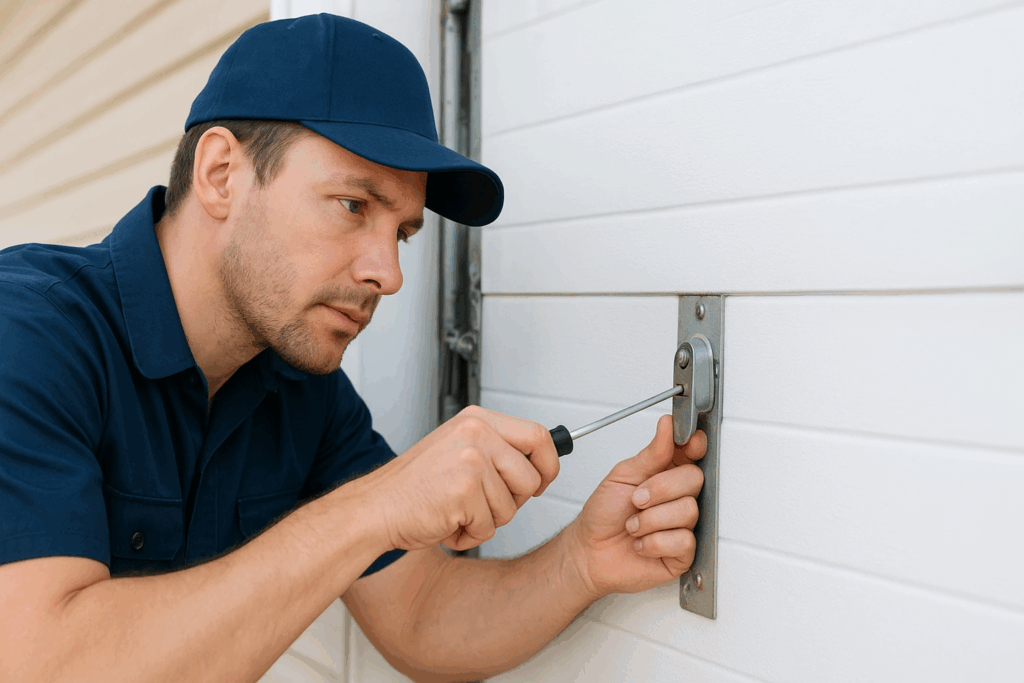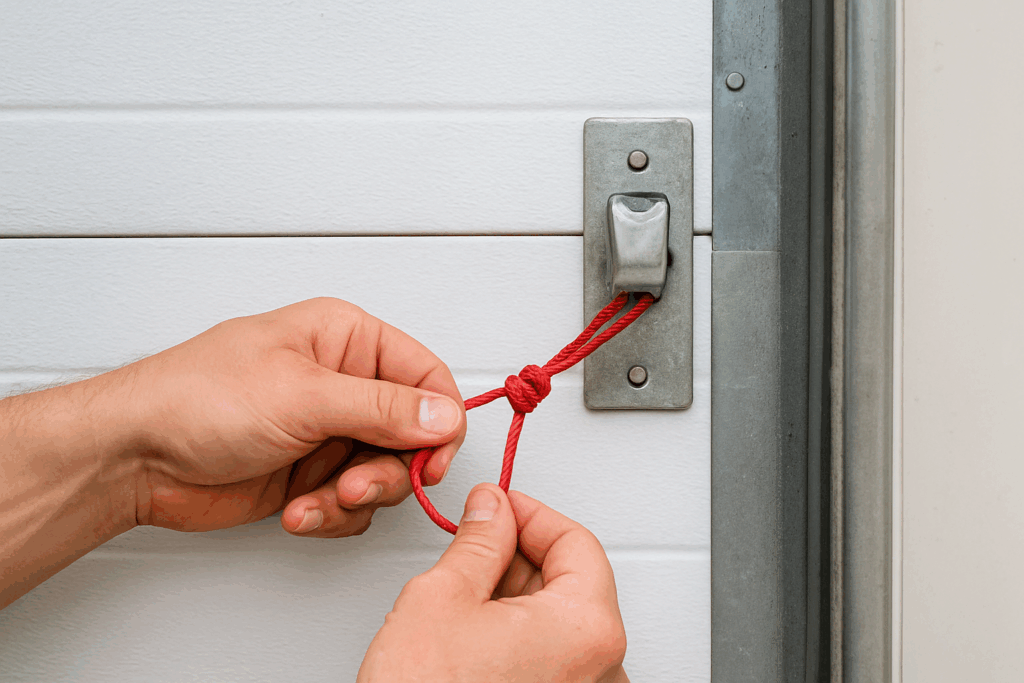Your garage door is more than just an entryway for your car — it’s a vital part of your home’s security and convenience. When it stops working smoothly, you feel it instantly. That’s why learning a few insider tricks from a professional Garage Door Locksmith can make all the difference.
Whether your door is jamming, the lock is stiff, or your remote has stopped responding, a few clever maintenance steps can prevent costly repairs. These small but effective hacks will help keep your garage door working perfectly while improving your home’s overall safety.
In this article, we’ll reveal 8 genius Garage Door Locksmith hacks that actually work. From upgrading your opener codes to securing the emergency release cord, these pro-level insights will help you handle small issues confidently and extend your system’s life — without calling for help every time.
1. Lubricate the Locks and Hinges Regularly
A common reason garage locks become stiff or jammed is a lack of proper lubrication. Dust, moisture, and rust build up over time, making it harder for the key to turn or for the lock mechanism to move freely.
Every experienced Garage Door Locksmith recommends cleaning and lubricating the lock at least once every three months. Start by wiping away visible dust with a dry cloth. Then, apply a graphite-based or silicone spray lubricant inside the keyhole and on the hinges. Avoid using oil-based sprays like WD-40 — they attract dirt and cause buildup.
Consistent lubrication ensures the locking mechanism moves smoothly, prevents corrosion, and prolongs the lifespan of both the door and the key system. This simple maintenance step is often all it takes to prevent expensive locksmith visits later on.
2. Reset and Reprogram Your Garage Door Opener Codes
If you’ve ever lost a remote or shared access with someone who no longer needs it, reprogramming your opener codes should be your next move. Many homeowners overlook this, leaving their homes vulnerable to unauthorized access.
Resetting the opener is easier than you think. Locate the “Learn” or “Program” button on your opener motor unit, press and hold it until the indicator light flashes, then follow your device’s reprogramming instructions.
Doing this erases all previous codes and sets a fresh one. For added safety, choose new PINs for keypad entry as well.
A qualified Garage Door Locksmith can also reprogram your opener for you — especially if you’re unsure which model you own or the process feels confusing. This small step significantly boosts home security and peace of mind.
3. Inspect Lock Alignment and Track Movement
Your garage door works hard every day — and with frequent use, screws loosen, tracks shift, and locks fall slightly out of alignment. Even minor misalignment can cause jamming, noisy operation, or strain on the motor.
Inspecting your door’s movement regularly helps catch these issues early. Open and close the door slowly, observing how the lock engages. If the door shakes or rubs, it’s likely a track or hinge alignment issue. Tighten any loose screws with a screwdriver and ensure the lock bolt fits snugly into its latch hole.
A professional Garage Door Locksmith begins every inspection with these small checks, ensuring the system runs smoothly and safely. Realigning components takes just a few minutes — but it can save you from major repairs in the future.

4. Upgrade to Smart Garage Door Locks
We live in a world where everything is getting smarter — and your garage should too. Smart locks are one of the best ways to modernize your home security while adding unmatched convenience.
Today’s smart garage locks let you:
- Control your door remotely from your smartphone
- Create temporary access codes for guests or service workers
- Receive real-time alerts if the door opens unexpectedly
Installing a smart lock also integrates your garage with the rest of your smart home ecosystem, like Alexa or Google Home.
A skilled Garage Door Locksmith can handle installation and ensure the lock syncs perfectly with your existing opener system. Smart locks not only provide advanced security but also eliminate the need for traditional keys — one less thing to worry about losing.
5. Check Weather Seals and Bottom Locks
Your garage door’s weather seals do more than just block drafts — they also protect your locks from moisture, dust, and pests. Over time, the rubber seal at the bottom of your door can crack or loosen, letting in water that leads to rust and mechanical wear.
Inspect your weather seals at least twice a year. Look for cracks, stiffness, or gaps that let in light. If you notice damage, replace the seal immediately.
While you’re at it, check the bottom locks and bolts for tightness. A corroded or loose bottom lock compromises both your garage’s security and insulation.
An experienced Garage Door Locksmith can quickly replace old seals and adjust your locking mechanism, ensuring everything fits snugly and operates efficiently — keeping your garage dry, warm, and safe year-round.
6. Secure the Emergency Release Cord Properly
The emergency release cord is essential for safety — it allows you to open the garage manually during a power outage. But unfortunately, burglars know how to exploit it by pulling it through a small gap at the top of the door.
To prevent this, install a simple cord shield or attach the release lever with a small zip tie. This keeps the system functional for emergencies but prevents easy external access.
A Garage Door Locksmith can show you how to secure it properly without disabling its safety function. It’s a small adjustment that can make a huge difference in keeping intruders out while ensuring your family stays safe in case of emergencies.
7. Test the Garage Door Lock System Monthly
Regular testing is the key to maintaining a secure and reliable garage door system. Just like smoke detectors or alarm systems, your garage door lock should be tested at least once a month.
Here’s a simple checklist:
- Manually lock and unlock the door to check for stiffness.
- Use the remote and keypad to confirm smooth operation.
- Listen for grinding or scraping noises.
- Observe the door’s alignment while closing.
If you notice any sticking or irregular movement, don’t ignore it. Early detection can prevent total lock failure or door jamming.
Every trusted Garage Door Locksmith encourages routine testing — it’s the easiest way to catch small issues before they turn into costly breakdowns.
8. Reinforce Garage Door Panels and Side Locks
Your garage door is only as strong as its weakest point — and for many homes, that’s the thin panels or side locks. Burglars often target these spots to pry open the door.
Reinforce your door by installing steel bars or heavy-duty lock plates. Consider upgrading to tamper-resistant side bolts for added protection.
A certified Garage Door Locksmith can install reinforcement bars or recommend deadbolt-style locking systems that blend seamlessly with your existing setup. Not only does this deter break-ins, but it also adds durability to your garage structure — keeping your home safer and more secure for years.

DIY Fixes vs. Professional Locksmith Help
| Issue | DIY Hack | When to Call a Garage Door Locksmith |
|---|---|---|
| Sticky Lock | Use graphite or silicone spray | If the key still jams after cleaning |
| Lost Remote | Reprogram opener codes | If reprogramming fails or opener resets |
| Misalignment | Tighten screws and hinges | If door still shakes or doesn’t close properly |
| Weak Security | Install smart lock | If wiring or app integration is required |
DIY maintenance can save money, but don’t risk damaging complex parts. When in doubt, trust a Garage Door Locksmith — they’re trained to handle these systems safely and efficiently.
Expert Tips from a Garage Door Locksmith
- Schedule a full inspection every six months.
- Always use lubricants specifically designed for locks.
- Avoid universal remotes — choose encrypted ones for better security.
- Keep the keypad area clean and dry.
- Store spare keys with someone you trust, not in your car or garage.
Following these expert suggestions from a Garage Door Locksmith ensures your system stays in top shape while maximizing long-term reliability and safety.
Common Mistakes Homeowners Make
Even with good intentions, many homeowners accidentally shorten their garage door’s lifespan by making simple errors:
- Using household oil instead of lock lubricant.
- Ignoring small grinding noises until the motor fails.
- Forgetting to change opener codes after renting or selling a home.
- Attempting to force jammed locks open.
- Neglecting to clean around the keypad and lock area.
A professional Garage Door Locksmith often ends up fixing these issues — and most could have been avoided with basic maintenance. Learning to identify and prevent these mistakes helps save both time and money.
Final Thoughts
Your garage door plays a major role in protecting your home and belongings, so giving it the care it deserves is essential. With these eight genius hacks, you can maintain smooth functionality, prevent lockouts, and strengthen your overall security.
From lubricating hinges to upgrading to smart locks, every tip here is practical and easy to follow. But remember — when you face stubborn or complex issues, it’s always wise to call a certified Garage Door Locksmith. They bring the right tools, knowledge, and expertise to keep your system running safely and efficiently.
Taking proactive steps now ensures you’ll enjoy a hassle-free, secure garage for years to come.
FAQ — Garage Door Locksmith Hacks
Q1: How often should I service my garage door locks?
At least twice a year or whenever you feel resistance when turning the key.
Q2: Can I replace a garage door lock myself?
Yes, but if it involves wiring or smart tech integration, call a Garage Door Locksmith.
Q3: Are smart garage locks safe?
Absolutely. They use encrypted technology that’s harder to hack than traditional systems.
Q4: Why does my garage door make squeaky sounds?
It’s usually due to lack of lubrication or misalignment. A quick inspection fixes it.
Q5: How much does a Garage Door Locksmith charge?
On average, between $75 and $200 depending on the complexity of the service.